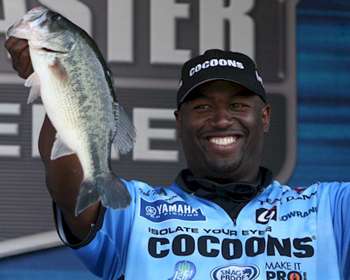
One of the current trends on the Bassmaster Elite Series is the reemergence of the straight shank worm hook. "The straight shank hook has the best hooking percentage out of all the hooks on the market," claims Elite Series pro Ish Monroe. "It's the style of hook that many of us started out using, but we got away from it because we got lazy.
When we got lazy, we also lost our hooking percentage," he says. "The extra-wide gap hook made it easier to rig the bait straight on the hook and you didn't have to sit there and fix the bait and pull the weeds off of the bait as much as you used to," Monroe continues. "However, even though it's a little easier to use, I've found that the hooking percentage is far better with a straight shank hook than with an extra-wide gap."
Monroe returned to the straight shank out of near desperation after going through a three-year stretch in his career where he was plagued by lost fish. "When the extra-wide gap hooks became popular, I started buying and using them," he remembers. "I started losing a lot more bass and I knew that I had to start changing some things. The first thing that I changed was my hook design back to a straight shank and, when I did that, I started putting all those bass in the boat again." The effectiveness of a straight shank worm hook is in its simplicity.
"When you look at the hook point in relation to the eye of the hook, they're not in line with each other and there's a big gap there," explains Monroe. "When you pull the hook through a bass' mouth, it's usually going to get hooked in the roof of the mouth or the bottom jaw.
Those are two areas where it's not going to get off very often." While all straight shank hooks may look identical, there are three key components that Monroe looks for when choosing the correct one. First and foremost is the sharpness of the hook.
Second, Monroe looks at the size of the barb. If the barb is too big, it hinders penetration. If the barb is too small, the hook won't grab onto the bass' mouth and it will slide back through the hole created during penetration.
Finally, Monroe stresses the importance of a barb on the shank of the hook located just below the eye in order to hold the bait in place. "The Paycheck Baits punch hook comes with a plastic barb that you can heat shrink onto the shank of the hook," he explains. "It does a really good job of keeping the bait rigged correctly." The California pro doesn't just limit straight shank hooks to flipping and pitching Texas-rigged plastics.
He often utilizes the same design of hook for finesse applications but alters the thickness of the hook wire. "I like to use a straight shank hook when I'm Texas rigging plastic worms in the 4- to 6-inch range," he says. "It's important to use a light wire hook because a heavy gauge will often hinder the action of a small worm." While Monroe dotes on the benefits of a straight shank hook, he says there are times when an offset hook is a better option, especially when fishing Texas rigged creature baits with a lot of bulk. "It's a lot easier to keep a bulky bait straight on the hook when you're using an offset hook," he states. "It just gives the bait a little bit more of a natural appearance and action."
For Ish Monroe, the benefits of a straight shank hook far outweigh the drawbacks. "All you're giving up is the half-second that it takes to make sure the bait remains rigged straight on the hook," he explains. "The difference between a good angler and an average angler is that a good angler won't get lazy and will take that extra split second to rig the bait correctly on a straight shank so it appears more natural."
(Provided by Z3 Media)




